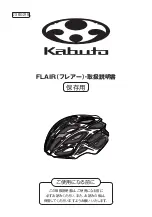
14
GAZELLE MANUAL
14
Bicycle Owner’s Manual
If you have a mountain or road bike equipped with
through axle front or rear wheels, make sure that your
dealer has given you the manufacturer’s instructions, and
follow those when installing or removing a through axle
wheel. If you don’t know what a through axle is, ask your
dealer.
If you do not have a bicycle with a through-axle wheel
mounting system, it will have wheels secured in one of
three ways:
• A hollow axle with a shaft (“skewer”) running through
it which has an
adjustable tension nut on one end and an over-center cam
on the other (cam action system, fig.8 a & b)
• A hollow axle with a shaft (“skewer”) running through
it which has a nut on one end and a fitting for a hex key,
lock lever or other tightening device on the other (through
bolt, fig. 9)
• Hex nuts or hex key bolts which are threaded on to or
into the hub axle (bolt-on wheel, fig. 10)
Your bicycle may be equipped with a different securing
method for the front wheel than for the rear wheel.
Discuss the wheel securing method for your bicycle with
your dealer.
It is very important that you understand the type of wheel
securing method on your bicycle, that you know how to
secure the wheels correctly, and that you know how to
apply the correct clamping force that safely secures the
wheel. Ask your dealer to instruct you in correct wheel
removal and installation, and ask him to give you any
available manufacturer’s instructions.
WARNING: Riding with an improperly secured wheel
can allow the wheel to wobble or fall off the bicycle,
which can cause serious injury or death. Therefore,
it is essential that you:
1. Ask your dealer to help you make sure you know how
to install and remove your wheels safely.
2. Understand and apply the correct technique for
clamping your wheel in place.
3. Each time, before you ride the bike, check that the
wheel is securely clamped.
The clamping action of a correctly secured wheel must
emboss the surfaces of the dropouts.
1. Front Wheel Secondary Retention Devices
Most bicycles have front forks which utilize a secondary
wheel retention device to reduce the risk of the wheel
disengaging from the fork if the wheel is incorrectly
secured. Secondary retention devices are not a substitute
for correctly securing your front wheel.
Secondary retention devices fall into two basic
categories:
a. The clip-on type is a part which the manufacturer
adds to the front wheel hub or front fork.
b. The integral type is molded, cast or machined into
the outer faces of the front fork dropouts.
Ask your dealer to explain the particular secondary
retention device on your bike.
WARNING: Do not remove or disable the secondary
retention device. As its name implies, it serves as a
back-up for a critical adjustment. If the wheel is not
secured correctly, the secondary retention device can
reduce the risk of the wheel disengaging from the fork.
Removing or disabling the secondary retention device may
also void the warranty.
Secondary retention devices are not a substitute for
correctly securing your wheel. Failure to properly secure
the wheel can cause the wheel to wobble or disengage,
which could cause you to loose control and fall, resulting
in serious injury or death.














































